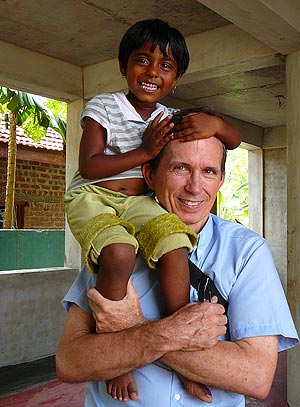|
| |||||
 He lives in Jacksonville but his heart is in Sri Lanka2009 interview with Murugan Bhakti editor Patrick Harrigan
Though he grew up in Michigan, Jacksonville resident Patrick Harrigan speaks English with a peculiar accent. That accent was acquired over two decades living in Sri Lanka, where he often spoke Sinhala and Tamil, the two predominant indigenous languages of the island nation off the Southeast coast of India. When Harrigan, now 59, first visited in 1971, Sri Lanka still was called Ceylon (the name of the former British colony was changed in 1972). Initially, he went there because he was interested in Buddhism, one of several religions found on the island, and because English was widely spoken (he hadn't learned the native languages yet). He immediately found himself drawn by the island's "rich, natural beauty," cultural diversity and a small but intellectually stimulating community of Westerners - including science fiction author and futurist Arthur C. Clarke ("2001: A Space Odyssey"). "I felt it really had a lot to offer me," said Harrigan, who was particularly attracted to the religious tolerance he found in a place where Buddhists, Hindus, Muslims and Christians all openly followed their faiths. The next year he made the first of many pilgrimages to Kataragama, an ancient shrine that seemed to epitomize the "interreligious dimension." The shrine, which dates from the Neolithic period, is sacred to the Hindu and Buddhist religions, as well as to the Sufi order of the Muslim religion. As was the ancient custom, he made the pilgrimage barefoot and shirtless, walking for 58 days down the east coast of the island and then into the jungle, stopping each night in a different village. At the end he spent three days in a hospital recovering. Over the next 20 years, while he pursued advanced degrees in comparative religion (he completed work on a doctorate but his dissertation was never accepted), he kept going back to the island on which he concentrated his academic research. Having spent two decades training as an expert on Sri Lankan culture, he became a resident in 1988. By then Sri Lanka had changed a lot from the country he had first visited, he said. The predominantly Buddhist, Sinhalese majority had taken control of the parliamentary government and instituted increasingly repressive measures against the Tamil minority, which included Hindus, Muslims and Christians. A civil war began in 1983 and continued until this May when the Tamil Tiger rebels finally were crushed. But while the religious tolerance that had first attracted him was disappearing from the country as a whole, Kataragama remained a place where people of several faiths co-existed and worshipped together.
Despite the fact that the traditional path of the Kataragama pilgrimage passed partly though war-torn territory then held by the Tamil rebels, Harrigan kept making as much of the annual trek as he could. At one point, the number of people making the annual pilgrimage had declined from thousands to just seven, he said. He also started and continues to administer a Web site, www.kataragama.org, devoted to scholarly research on the shrine. Despite the war, he lived happily in Sri Lanka, researching and writing, supporting himself by working for nonprofit nongovernmental organizations called NGOs. When a tsunami arose in the Indian Ocean in late December 2004 and devastated much of Southeast Asia, Harrigan, because he knew the culture and the languages, was approached by both news organizations and charitable groups who wanted to help. Pandiruppu, a small village on Sri Lanka's east coast, which Harrigan had visited annually during his coastal pilgrimage, had lost 1,711 people in the tsunami. Working with the Kiwanis Club of Eastern Canada, Harrigan started the Kiwanis Visions of Hope Children's Center, which provides pre- and after-school programs for about 100 kids in the village. There they could receive education and therapy, drink fresh milk and eat fresh vegetables, and relax in a nurturing environment that had been lost when the waves struck. By last spring Harrigan was devoting most of his time to the center, which had a staff of 14 and a budget of about $1,500 a month. But Sri Lanka's government, increasingly hostile to foreigners, passed a law in 2008 that decreed foreigners in the country for longer than three years would not have their visas renewed. As a result, Harrigan had to leave at the end of April 2009. A friend in Jacksonville offered him a job. Harrigan, who has never married, moved to an apartment off Baymeadows Road in May and went to work at Jacksonville Advanced Machining, headquartered in an office park off Philips Highway. Leaving Sri Lanka didn't mean severing ties with the Visions of Hope Project, he said. At ten p.m. in Jacksonville, it's morning in Sri Lanka and Harrigan is in daily contact via the Internet and cell phone. In effect, he's working two full-time jobs. The big challenge now is to raise funds to keep the operation going. Recent deficits forced staff members to take pay cuts and the milk program had to be discontinued, said Harrigan, who receives no salary. For more on the project go to www.navashakti.org. Harrigan isn't sure whether he'll return to Sri Lanka to live. "I washed up here in Jacksonville," 'he said. "Now I have time to pause and reflect." Interviewed by Charlie Patton © Jacksonville Times-Union of October 12, 2009 |

